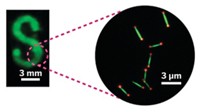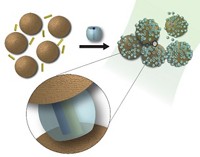Advertisement
Grab your lab coat. Let's get started
Welcome!
Welcome!
Create an account below to get 6 C&EN articles per month, receive newsletters and more - all free.
It seems this is your first time logging in online. Please enter the following information to continue.
As an ACS member you automatically get access to this site. All we need is few more details to create your reading experience.
Not you? Sign in with a different account.
Not you? Sign in with a different account.
ERROR 1
ERROR 1
ERROR 2
ERROR 2
ERROR 2
ERROR 2
ERROR 2
Password and Confirm password must match.
If you have an ACS member number, please enter it here so we can link this account to your membership. (optional)
ERROR 2
ACS values your privacy. By submitting your information, you are gaining access to C&EN and subscribing to our weekly newsletter. We use the information you provide to make your reading experience better, and we will never sell your data to third party members.
Materials
Sandwichlike sensors sniff out organic water contaminants
Design of the fluorescent nanosheets was inspired by dog noses
by Matt Davenport
September 29, 2016
| A version of this story appeared in
Volume 94, Issue 39

Taking a cue from canine noses, a research team has developed fluorescent sensors that sniff out organic contaminants in water.
The current methods used to detect volatile organic compounds, such as xylenes, in water are time-consuming or require sophisticated equipment, contends the team led by Guodong Liang of Sun Yat-sen University and Ben Zhong Tang of Hong Kong University of Science & Technology. The researchers believe fluorescent nanosheets that build themselves could help change that (ACS Sens. 2016, DOI: 10.1021/acssensors.6b00530).
Their sensors rely on hydrophilic cyclodextrin molecules tethered to fluorescent tetraphenylethene groups. When added to an aqueous solution, these structures self-assemble into nanoscopic, sandwichlike sheets about 4 nm thick. Two layers of cyclodextrin act as the bread slices surrounding a filling of aggregated tetraphenylethene.
Although the exterior of the circular cyclodextrin molecules are hydrophilic, they have hydrophobic interior cavities. These cavities collect and funnel volatile organic molecules into the tetraphenylethene layer. Once in that layer, the contaminants dim the fluorescing compounds. The design of the self-assembled sheets is modeled after dog noses, which use bony structures, rather than cyclodextrin, to accumulate scent molecules for receptors, the team says.
The sensors concretely illustrate the relationship between a material’s structure and its behavior, comments Andrea Pucci, who develops functional polymers at the University of Pisa. Pucci, who was not involved in the study, adds that the Chinese team’s work provides a “very nice example of the application of solid-state fluorescence in the development of modern optical sensors.”
The fluorescent nanosheets are extremely sensitive to aromatic xylenes with a limit of detection at 5 µg/L, the team says. The sensitivity may result from the size of the hydrocarbons matching that of the sensor’s cyclodextrin cavities.
Other pollutants, such as hexane, acetone, and methanol, also dim the sensors, but not as markedly as xylenes. The researchers continue to develop robust detectors for various pollutants, they tell C&EN.





Join the conversation
Contact the reporter
Submit a Letter to the Editor for publication
Engage with us on Twitter